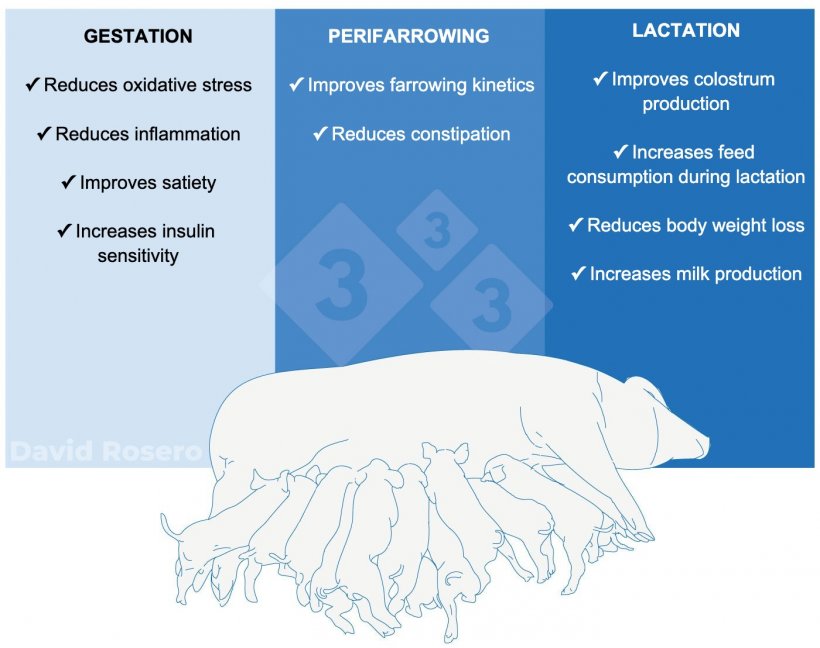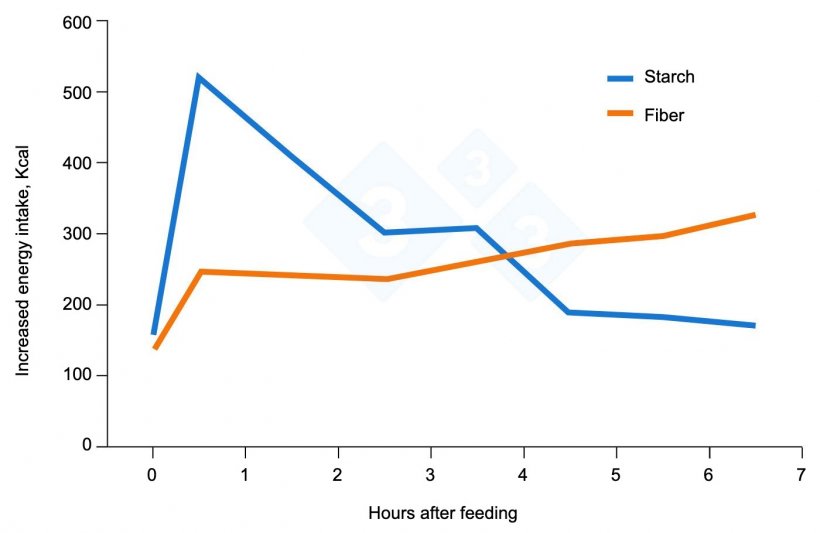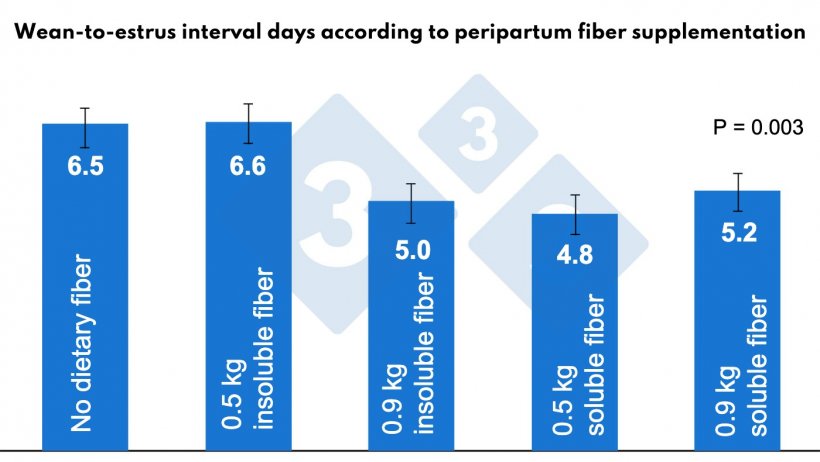Recent research has helped determine the benefits of dietary fiber on sow welfare, productivity, and longevity in commercial farms (Figure 1). In addition, improvements in analytical techniques are allowing better characterization of fiber's functional components and their relationship to sow physiology and metabolism.

Figure 1. Effects of fiber as a nutritional intervention in sow diets.

Characterization of dietary fiber
Dietary fiber is the most complex and diverse nutrient, and until very recently, analytical techniques underestimated fiber concentrations in major ingredients. On the other hand, the physiological roles of fiber are difficult to measure accurately on a routine basis. The structural complexity of fiber, determined by the composition of monosaccharides, linkages, and chain configurations, limits its chemical characterization and has necessitated its definition based on the methodology used. Recent advances in analytical techniques have allowed better definition and characterization of fiber components, including total dietary fiber, soluble fiber, and insoluble fiber.
Beyond fiber chemical characterization, physicochemical properties such as solubility, viscosity, cation exchange capacity, and water retention are directly related to physiological effects in sows (Feyera et al., 2017, Crome, 2023)
Benefits of fiber in gestation
Emerging evidence suggests that using fiber in gestating sow diets contributes significantly to their welfare, reducing stress and behavioral problems observed in group housing systems (Sapkota et al., 2016). In addition, fiber supplementation in gestation diets has been linked to a reduced number of stillborn piglets, higher piglet birth weights, higher feed intake of lactating sows, and lower pre-weaning mortality in piglets (Feyera et al., 2017).
The physicochemical properties and bulk density of fiber reduce the passage of feed through the gastrointestinal tract, prolonging satiety in gestating sows. In addition, once fiber is consumed, its fermentation produces short-chain fatty acids that stimulate the release of satiety-related hormones such as GLP-1, CCK, and PYY (Crome, 2023). Another of fiber's properties is the slow absorption of glucose into the bloodstream, which results in a more stable glucose and insulin response and prevents rapid fluctuations in blood sugar levels that can lead to hunger.
Recently, we demonstrated that while a high-fiber gestation diet (total dietary fiber of 18% for the High Fiber treatment and 9% for Low Fiber) did not affect reproductive performance, litter size, individual piglet weight, or pre-weaning mortality, it did reduce weight loss during lactation (Paz, 2022).
In a second study conducted on a commercial farm (preliminary data, Figure 2), we formulated gestation diets using much higher levels of fiber (32% and 14% total dietary fiber for High Fiber and Low Fiber treatments, respectively). Feeding High Fiber to gestating sows reduced their overall mortality (P = 0.157, 4.36% vs. 7.05% for High and Low Fiber treatments, respectively), especially for those sows categorized as death due to lameness (P = 0.087, 0.67% vs. 2.56%, respectively).

Figure 2. Effects of fiber use during gestation on sow survival.
Role of fiber in the perifarrowing period
Dietary fiber supplementation during the perifarrowing phase has been shown to reduce farrowing duration and stillbirth incidence (Theil et al., 2014). We hypothesize that these benefits are related to reduced constipation (Cardona et al., 2024) and improved energy status of sows through increased availability of short-chain fatty acids resulting from enhanced fermentation (Figure 3, Feyera et al., 2017).

Figure 3. Effects of fiber as a nutritional intervention in sow diets. Adapted from Serena et al., 2009.
Constipation during the perifarrowing period can affect sow productivity, lengthening farrowing duration and increasing the incidence of stillborn piglets. Dietary fiber helps relieve constipation by increasing fecal volume and promoting regular bowel movements. Recent research by Cardona et al. (2024) showed that fiber supplementation during late gestation reduced constipation by 21%, decreased farrowing duration, and reduced pre-weaning mortality in piglets by 16%. Some fiber sources with high water holding capacity, such as soybean hulls, lignocellulose, and sugar beet pulp, improve fecal hydration and intestinal motility.
In addition, fiber fermentation provides sustained energy, meeting the energy demands of farrowing and increasing colostrum production. Based on these findings, we designed a fiber supplement with the goal of providing over 500 g of total dietary fiber and over 100 g of soluble fiber, which was administered during the perifarrowing period. This fiber supplement reduced the wean-to-estrus interval, improving sows' reproductive efficiency (Figure 4, Martinez et al., 2022)

Figure 4. Effects of fiber during the perifarrowing period on the wean-to-estrus interval. Adapted from Martínez, 2022.
Conclusion
Integrating dietary fiber into sow nutrition programs has great potential to improve gastrointestinal health, animal welfare, sow longevity and reproduction, and piglet survival. However, it is necessary to deepen the characterization of dietary fiber, study its relationship with sow physiology, and apply this new knowledge in developing new feeding strategies that contribute to the sustainability and profitability of swine production systems.



